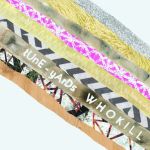
The musical act Tune-Yards (stylized as tUnE-yArDs) released their sophomore album Who Kill in April 2011 to much-critical acclaim. Largely described as experimental music, front-runner Merrill Garbus combines elements of multiple genres, ranging from acoustic folk and free jazz to R&B and Afro-beat. Who Kill has been ranked as one of the Top 50 Albums of 2011 by many media outlets, reaching as high as No. 7 on Pitchfork Media’s own list.
Garbus employs many creative, often dissonant techniques throughout Who Kill to compare and contrast current social issues, ranging from abortion to the ignored and marginalized poor of America.
Consisting of 10 tracks, the album opens explosively with “My Country,” a song that satirically includes the lines “My country ‘tis of thee / Sweet land of liberty,” from the patriotic song “America.” This first track twists the lines by superseding the subsequent lines with a pointed, introspective question: “How come I cannot see / My future within your arms?”
“My Country” opens up to pose more questions to the listener, including, “Why is there juice dripping under your chin / When they have nothing, why do you have something?” and “Well, what do you want me to say to the others? / Oh, yes, there’s a place for you / But that place is underneath the cushion of my behind.” The song makes use of these two separate perspectives, constructing a quasi-debate that has raged throughout society ad nauseam.
As with much of Who Kill, “My Country” accounts for many issues that are being voiced during the current Occupy movement, despite its release a few months before the movement’s conception. Garbus herself coincidentally supports the movement, particularly through her Twitter account.
The second and third tracks, “Es-So” and “Gangsta,” deal with eating disorders and race and class relations respectively. Like “My Country,” the songs are structured with the use of rhetorical questions in order to present these difficult topics.
In “Es-So,” Garbus takes on the perspective of an adolescent girl, asking, “I gotta do right if my body’s tight, right?” The song ends on a powerful note, signifying the destructive nature of eating disorders: “It is true, daddy. It is true, daddy / I run over my own body with my own car.”
“Gangsta” is perhaps the most powerful and thought-provoking song on Who Kill. Yet again Garbus utilizes fictional characters, initiating the lyrical conversation by asking “What’s a boy to do if he’ll never be a gangsta? / Anger in his heart, but he’ll never be a gangsta?”
As is made evident throughout the duration of the song, this thematic approach to race and class largely suggests that they’re more related than they’re perceived to be; Merrill implies socio-economic differences between the “wannabe gangsta” and his true counterpart, the authoritative voice that advises he “Never move to my hood / Cause danger is crawling out the wood.” In addition, the mention of “anger in his heart” symbolizes the subject’s internal similarity to the gangsta, although that’s where their similarities stop, much to the wannabe’s disappointment.
The song “Gangsta” ends as powerfully and realistically as “Es-So,” reducing its message to a simple explanation of inner-city struggles: “Life in the city makes more sense when Jesus calls me daddy.” This line portrays the idea of the self as “God” – the perceived equivalent of the “true” gangsta’s day-to-day struggles against his external environment.
Although these are only the first three of the 10 tracks that comprise Who Kill, they provide an adequate illustration of the major themes explored in the album and Garbus’ lyrical deliberation to provide the voiceless with voices.
Personally an advocate for all that the Occupy movement stands for, I can’t help but appreciate the novelty of Merrill Garbus’ perspective. In a world dominated by big business and the often mindless Top 40 songs that crowd radio frequencies nationwide, the themes that Garbus explores and presents so authentically persist as understated and under-appreciated, even despite their urgent nature.
It’s an album worth investing in, to say the very least.


